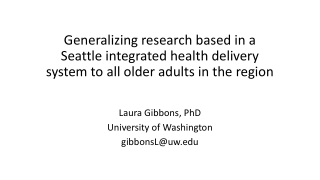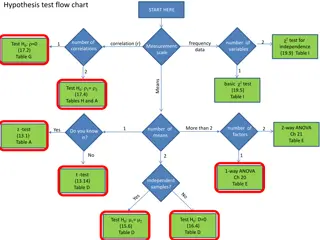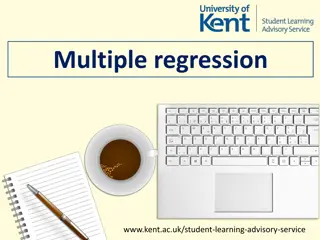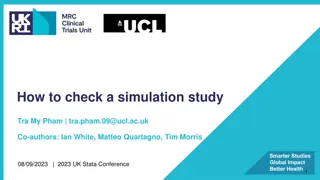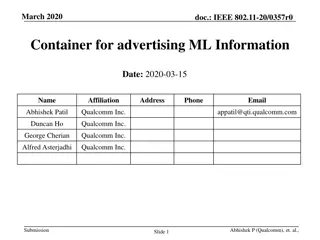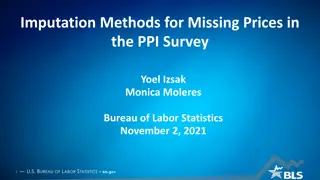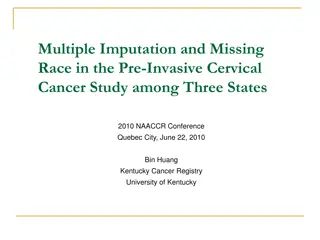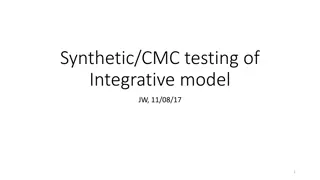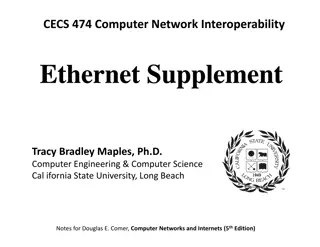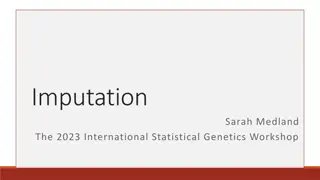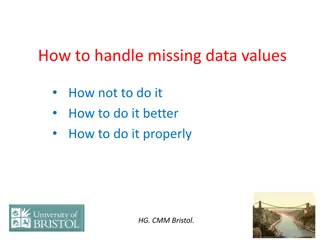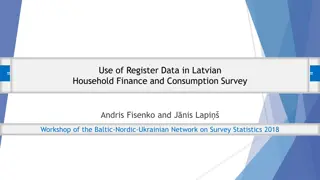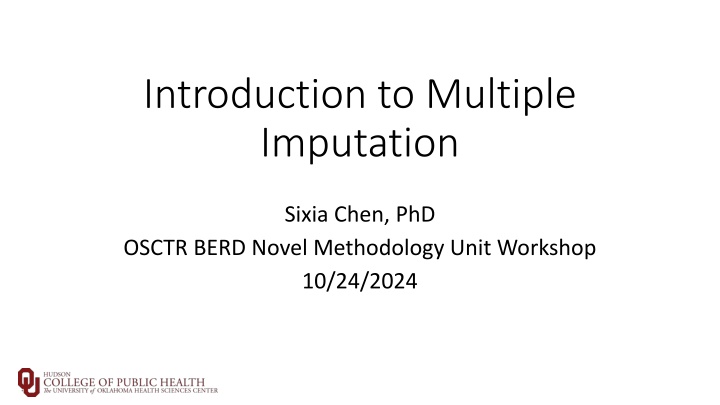
Missing Data Analysis: A Comprehensive Workshop Overview
Explore the nuances of missing data analysis in this workshop led by Dr. Sixia Chen. Learn about unit and item nonresponse, practical applications of multiple imputation methods using SAS, and more. Delve into real data scenarios and gain fundamental knowledge to implement these techniques effectively.
Download Presentation

Please find below an Image/Link to download the presentation.
The content on the website is provided AS IS for your information and personal use only. It may not be sold, licensed, or shared on other websites without obtaining consent from the author. If you encounter any issues during the download, it is possible that the publisher has removed the file from their server.
You are allowed to download the files provided on this website for personal or commercial use, subject to the condition that they are used lawfully. All files are the property of their respective owners.
The content on the website is provided AS IS for your information and personal use only. It may not be sold, licensed, or shared on other websites without obtaining consent from the author.
E N D
Presentation Transcript
Introduction to Multiple Imputation Sixia Chen, PhD OSCTR BERD Novel Methodology Unit Workshop 10/24/2024
Acknowledgement This workshop was supported by the Oklahoma Shared Clinical and Translational Resources (U54GM104938) with an Institutional Development Award (IDeA) from NIGMS. The content is solely the responsibility of the authors and does not necessarily represent the official views of the National Institutes of Health
Please keep presentation slides, data files, and computational codes confidential and don t share with others Please use the data files only for the purpose of this short course We will only use SAS for real data applications and in-class exercise
Course Objectives Obtain basic knowledge of missing data and multiple imputation Implement multiple imputation method by using SAS Apply multiple imputation method in practice
Outline 1. Introduction to missing data analysis 2. Multiple imputation method 3. Computational tools 4. Real data application 5. Discussion
1. Introduction to missing data analysis
Introduction - Types of missing data Unit nonresponse: it occurs when an entire unit, such as a person, household, or case, fails to provide any data for the survey or study. This means that none of the variables or questions related to that unit have been answered or collected Item nonresponse: it occurs when a participant or respondent provides some data but fails to answer one or more specific questions or variables in a survey or study
Introduction - Examples The Behavioral Risk Factor Surveillance System (BRFSS): nation s premier system of health-related telephone surveys that collect state data about U.S. residents regarding their health-related risk behaviors, chronic health conditions, and use of preventive services Unit nonresponse: refusal and incorrect contact information from the sampled units Item nonresponse: respondents fail to answer some questions such as age, gender, health outcomes, etc
Unit nonresponse The response rate for the 2023 Behavioral Risk Factor Surveillance System (BRFSS) was approximately 19.5% The response rate for the 2023 National Health and Nutrition Examination Survey (NHANES) was around 60% The response rate for the 2023 National Health Interview Survey (NHIS) was approximately 56.7%
Item nonresponse (2023 BRFSS) Weighted Percentage Value Value Label Frequency Percentage 1 Less than $15,000 Notes: INCOME3=1,2 19,187 4.43 4.88 2 $15,000 to < $25,000 Notes: INCOME3=3,4 31,069 7.17 7.53 3 $25,000 to < $35,000 Notes: INCOME3=5 38,508 8.89 8.88 4 $35,000 to < $50,000 Notes: INCOME3=6 47,502 10.96 10.42 5 $50,000 to < $100,000 Notes: INCOME3=7,8 107,027 24.70 22.29 6 $100,000 to < $200,000 Notes: INCOME3=9,10 76,637 17.69 17.49 7 $200,000 or more Notes: INCOME3=11 26,770 6.18 6.78 9 Don t know/Not sure/Missing Notes: INCOME3=77, 99, or Missing 86,623 19.99 21.73
Toy example ID 1 2 3 4 5 6 7 8 True Annual Income 50000 120000 180000 20000 70000 30000 90000 35000 Observed Annual Income 50000 20000 70000 30000 35000 True average income: 74,375 Observed average income: 41,000 Bias (%)=(41,000-74,375)/74,375=-44.9%
Introduction - Strategies Unit nonresponse: Calibration or propensity score weighting Item nonresponse: Imputation Goal: Reduce nonresponse bias due to missing data Imputation: the process of replacing missing data with substituted values. The goal of imputation is to create a complete dataset that allows for standard statistical analyses, even when some data points are missing. By filling in these gaps, researchers aim to minimize the bias and inefficiency that can arise from incomplete data
Introduction Types of imputation methods Single imputation: Generate imputed value one single time Mean/Mode imputation Regression imputation Hot-deck imputation Nearest neighbor imputation Multiple imputation: Generate multiple imputed values
Introduction Missing mechanism Missing Completely at Random (MCAR): the probability of a data point being missing is independent of both the observed and unobserved data Missing Completely at Random (MAR): the probability of a data point being missing is related to the observed data but not to the unobserved data Not Missing at Random (NMAR): the probability of a data point being missing is related to the unobserved, missing data itself
2. Multiple imputation method
Concept Multiple imputation is a statistical technique used to handle missing data by creating multiple complete datasets, each with different plausible values imputed for the missing data. These datasets are then analyzed separately, and the results are combined to produce final estimates that account for the uncertainty introduced by the missing data
Computational details (Step 1). Generate ? imputed data files (Step 2). Compute ? point estimates ??and variance estimates ??= ?( ??) for k = 1,2, ? (Step 3). Compute the final combined MI estimate ? = ? 1 ?=1 (Step 4). Compute the final combined variance estimator based on the Rubin s formula: T = ? + 1 + ? 1?, where ? = ? 1 ?=1 is the within imputation variance and B = (? 1) 1 ?=1 ? (Step 5). Obtain confidence intervals based on ?, ?, and t distribution ?? ? ?? ? ?? ? 2is the between imputation variance
Degrees of Freedom for t distribution The degrees of freedom associated with the pooled estimate can be approximated as: When ?? is large, it can be approximated by using normal distribution
Relative Increase in Variance (RIV) In multiple imputation (MI), the relative increase in variance (RIV) measures how much the variance of an estimate increases due to the uncertainty introduced by imputing missing data, compared to if there were no missing data. It quantifies the additional uncertainty associated with estimating the missing values. Formula:
Interpretation The RIV helps understand how much missing data impacts the reliability of the estimates after multiple imputation. As m increases (more imputations), the RIV decreases, leading to more stable estimates Rule of Thumb: RIV<0.1: Good handling of missing data RIV between 0.1 and 0.3: Acceptable, but some increased variance due to missing data RIV>0.5: Suggests a need for careful review of the imputation process or increasing the number of imputations
Fraction of Missing Information (FMI) Formula: Rule of Thumb: FMI<0.1: Good; minimal impact from missing data FMI between 0.1 and 0.3: Acceptable; moderate but manageable impact FMI>0.3: Significant influence from missing data; requires closer examination of the imputation strategy
Relative Efficiency It measures how close (efficient) the variance of the estimate based on multiple imputation is to the variance of the estimate that would be obtained with fully complete data Formula: RE>0.95 is acceptable
History Concept Introduction (1978): Rubin introduced the concept of MI in his 1978 paper, where he outlined the theoretical framework Formalization and Implementation (1980s-1990s): Rubin and others formalized the methodology, developed algorithms, and implemented MI in various statistical software packages. Rubin s 1987 book, Multiple Imputation for Nonresponse in Surveys, is considered a seminal work in the field, providing a comprehensive treatment of the theory and application of MI Wider Adoption (1990s-2000s): As computational power increased and software tools improved, MI became more widely adopted in various fields, including social sciences, epidemiology, and economics
Conditions Missing at Random (MAR) Assumption Proper Specification of the Imputation Model Inclusion of All Relevant Variables: include all variables that are related to the missing data and the analysis model Sufficient Number of Imputations (At least 20) Convergence of the Imputation Process Compatibility Between Imputation and Analysis Models Proper Handling of Multicollinearity
Advantages of MI Reduces bias Reflects uncertainty due to imputation Preserves relationships among variables Flexible and generalizable Compatible with standard analysis methods Widely available in software
Disadvantages of MI Computationally intensive Complex implementation Assumes MAR Risk of model mis-specification Potential for increased variability Interpretation challenges Dependence on proper software use
Computational tools of MI R: Flexible and comprehensive, with packages like mice, Amelia, and missForest. SAS: Powerful for MI with PROC MI and PROC MIANALYZE. SPSS: User-friendly with a GUI for MI through its MVA module. Stata: Extensive support for MI with the mi command. Mplus: Excellent for structural equation modeling with MI. Python: Libraries like Fancyimpute and Statsmodels offer MI functionality. Standalone: Tools like Amelia and others by Schafer for specific MI needs.
SAS PROC MI Proc MI seed=04180 nimpute=20 min=0 1 0 . . max=3 5 6 . . round=1 1 1 . . data=indat out=indat2; Class X4 X5; fcs reg(X1=X3 X4 X5); fcs logistic(X4=X1); fcs REGPMM(X2); Var X1 X2 X3 X4 X5; By C1; /*indat needs to be sorted by C1 first*/ Run;
SAS code examples Means Linear Regression model Generalized Linear Model Percentages and Frequency Logistic regression model Nominal Logistic Model Mixed effect model
Data and variables 2017-2018 National Health Nutrition and Examination Survey (NHANES): https://wwwn.cdc.gov/nchs/nhanes/continuousnhanes/default.aspx? BeginYear=2017 Data file: Demographics Data Variables: RIDAGEYR DMDHHSIZ RIAGENDR RIDRETH1 DMDEDUC2 (missing) DMDMARTL (missing) INDFMIN2 (missing) Research question: Examine the association between INDFMIN2 and other variables
Multiple imputation (MI) is effective in terms of reducing nonresponse error and improving efficiency There are existing computational tools (SAS, R, etc.) MI is flexible in terms of handling different data types
Reference Griswold, W., and N. Wright. 2004. Cowbirds, Locals, and the Dynamic Endurance of Regionalism. American Journal of Sociology109 (6): 1411 51. Martin, K.A. 2009. Normalizing Heterosexuality: Mothers Assumptions, Talk, and Strategies with Young Children. American Sociological Review 74: 190 207. O'Brien, R. 2017. Redistribution and the New Fiscal Sociology: Race and the Progressivity of State andLocal Taxes. American Journal of Sociology122 (4): 1015 49. Sagar, T., D. Jones, K. Symons, J. Tyrie, and R. Roberts. 2016. Student Involvement in the UK Sex Industry: Motivations and Experiences. British Journal of Sociology67 (4): 697 718

